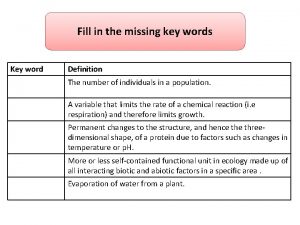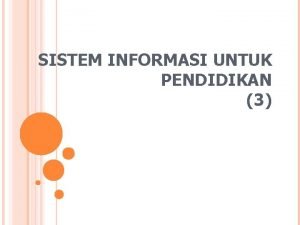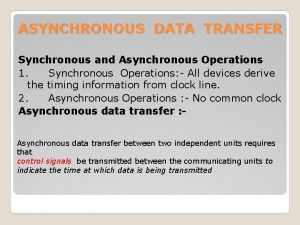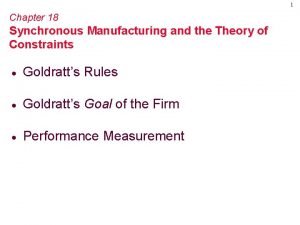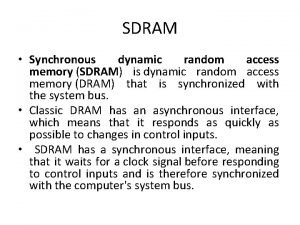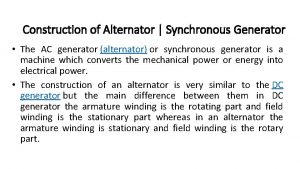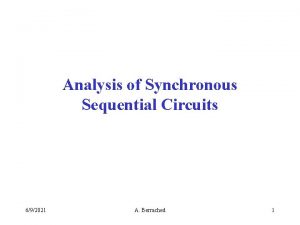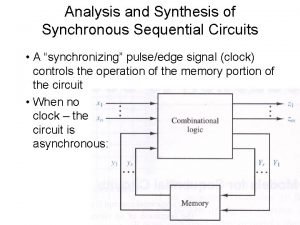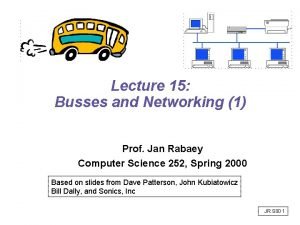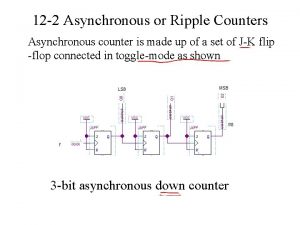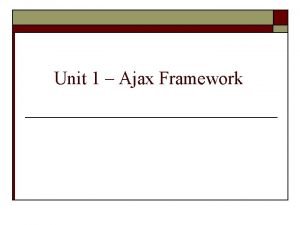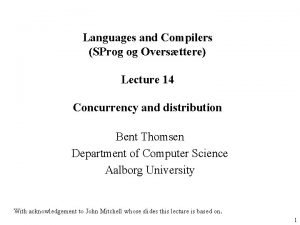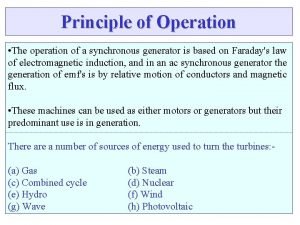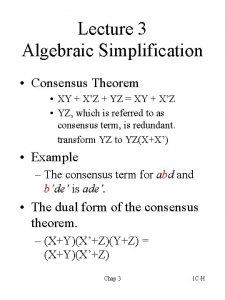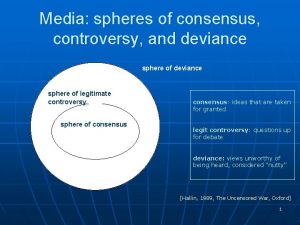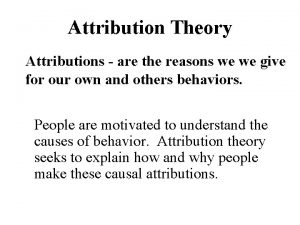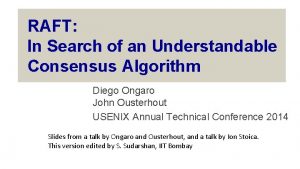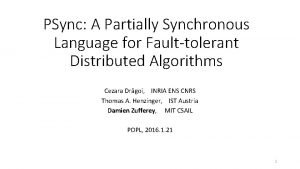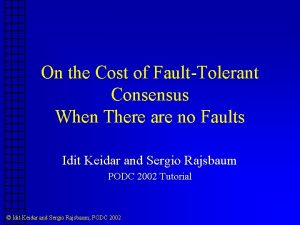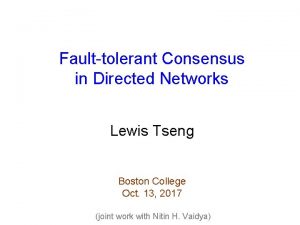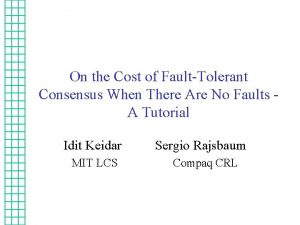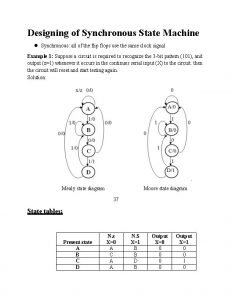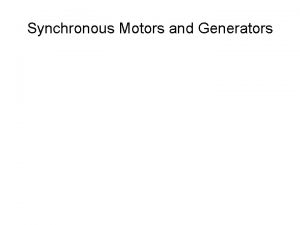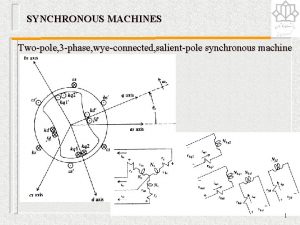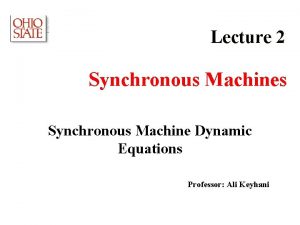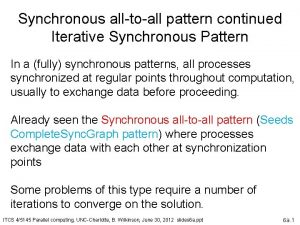FaultTolerant Consensus 1 Communication Model Complete graph Synchronous


























































































































- Slides: 122

Fault-Tolerant Consensus 1

Communication Model • Complete graph • Synchronous, network 2

Broadcast a a Send a message to all processors in one round 3

a a At the end of round: everybody receives a 4

Broadcast a b a b Two or more processes can broadcast at the same round 5

a, b b a, b a a, b 6

Crash Failures a Faulty processor a a a 7

Faulty processor a a Some of the messages are lost, they are never received 8

a Faulty processor a 9

Round Round 1 2 3 4 5 Failure After failure the process disappears from the network 10

Consensus 0 Start 1 4 2 3 Everybody has an initial value 11

3 Finish 3 3 Everybody must decide the same value 12

Validity condition: If everybody starts with the same value they must decide that value Start Finish 1 1 13

A simple algorithm Each processor: 1. Broadcast value to all processors 2. Decide on the minimum (only one round is needed) 14

Start 0 1 4 2 3 15

Broadcast values 0, 1, 2, 3, 4 1 4 2 3 0, 1, 2, 3, 4 16

Decide on minimum 0, 1, 2, 3, 4 0 0 0, 1, 2, 3, 4 17

Finish 0 0 0 18

This algorithm satisfies the validity condition Start Finish 1 1 1 1 1 If everybody starts with the same initial value, everybody decides on that value (minimum) 19

Consensus with Crash Failures The simple algorithm doesn’t work Each processor: 1. Broadcast value to all processors 2. Decide on the minimum 20

Start fail 0 1 0 0 2 4 3 The failed processor doesn’t broadcast Its value to all processors 21

Broadcasted values fail 0 0, 1, 2, 3, 4 1 1, 2, 3, 4 4 2 3 1, 2, 3, 4 0, 1, 2, 3, 4 22

Decide on minimum fail 0 0, 1, 2, 3, 4 0 1, 2, 3, 4 1 1 0 1, 2, 3, 4 0, 1, 2, 3, 4 23

Finish fail 0 0 1 1 0 No Consensus!!! 24

If an alforithm solves consensus for f failed process we say it is: an f-resilient consensus algorithm 25

Example: The input and output of a 3 -resilient consensus algorithm Start Finish 0 1 1 2 4 3 1 26

An f-resilient algorithm Round 1: Broadcast my value Round 2 to round f+1: Broadcast any new received values End of round f+1: Decide on the minimum value received 27

Example: f=1 failures, f+1 = 2 rounds needed Start 0 1 4 2 3 28

Example: f=1 failures, f+1 = 2 rounds needed Round 1 0 fail 0 0, 1, 2, 3, 4 1 0 (new values) 1, 2, 3, 4 2 3 4 1, 2, 3, 4 0, 1, 2, 3, 4 Broadcast all values to everybody 29

Example: f=1 failures, f+1 = 2 rounds needed Round 2 0, 1, 2, 3, 4 1 0, 1, 2, 3, 4 4 2 3 0, 1, 2, 3, 4 Broadcast all new values to everybody 30

Example: f=1 failures, f+1 = 2 rounds needed Finish 0, 1, 2, 3, 4 0 0 0 0, 1, 2, 3, 4 Decide on minimum value 31

Example: f=2 failures, f+1 = 3 rounds needed Start 0 1 4 2 3 Another example execution with 3 failures 32

Example: f=2 failures, f+1 = 3 rounds needed Round 1 0 Failure 1 1, 2, 3, 4 0 2 3 4 1, 2, 3, 4 0, 1, 2, 3, 4 Broadcast all values to everybody 33

Example: f=2 failures, f+1 = 3 rounds needed Round 2 0 Failure 1 0, 1, 2, 3, 4 1 1, 2, 3, 4 4 2 3 1, 2, 3, 4 0, 1, 2, 3, 4 Failure 2 Broadcast new values to everybody 34

Example: f=2 failures, f+1 = 3 rounds needed Round 3 0 Failure 1 0, 1, 2, 3, 4 4 2 3 O, 1, 2, 3, 4 0, 1, 2, 3, 4 Failure 2 Broadcast new values to everybody 35

Example: f=2 failures, f+1 = 3 rounds needed Finish 0 Failure 1 0, 1, 2, 3, 4 0 0 3 O, 1, 2, 3, 4 0, 1, 2, 3, 4 Failure 2 Decide on the minimum value 36

Example: f=2 failures, f+1 = 3 rounds needed Start 0 1 4 2 3 Another example execution with 3 failures 37

Example: f=2 failures, f+1 = 3 rounds needed Round 1 0 Failure 1 1, 2, 3, 4 0 2 3 4 1, 2, 3, 4 0, 1, 2, 3, 4 Broadcast all values to everybody 38

Example: f=2 failures, f+1 = 3 rounds needed Round 2 0 Failure 1 0, 1, 2, 3, 4 4 0, 1, 2, 3, 4 3 2 Broadcast new values to everybody Remark: At the end of this round all processes know about all the other values 39

Example: f=2 failures, f+1 = 3 rounds needed Round 3 0 Failure 1 0, 1, 2, 3, 4 4 2 3 0, 1, 2, 3, 4 Failure 2 Broadcast new values to everybody (no new values are learned in this round) 40

Example: f=2 failures, f+1 = 3 rounds needed Finish 0 Failure 1 0, 1, 2, 3, 4 0 0 3 0, 1, 2, 3, 4 Failure 2 Decide on minimum value 41

If there are f failures and f+1 rounds then there is a round with no failed process Round 1 2 3 4 5 6 Example: 5 failures, 6 rounds No failure 42

In the algorithm, at the end of the round with no failure: • Every (non faulty) process knows about all the values of all other participating processes • This knowledge doesn’t change until the end of the algorithm 43

Therefore, at the end of the round with no failure: everybody would decide the same value However, we don’t know the exact position of this round, so we have to let the algorithm execute for f+1 rounds 44

Validity of algorithm: when all processes start with the same input value then the consensus is that value This holds, since the value decided from each process is some input value 45

A Lower Bound Theorem: Any f-resilient consensus algorithm requires at least f+1 rounds 46

Proof sketch: Assume for contradiction that f or less rounds are enough Worst case scenario: There is a process that fails in each round 47

Worst case scenario Round 1 a before process fails, it sends its value a to only one process 48

Worst case scenario Round 1 2 a before process fails, it sends value a to only one process 49

Worst case scenario Round 1 2 3 f ……… a At the end of round f only one process knows about value a 50

Worst case scenario Round 1 2 3 f decide b ……… a Process may decide a, and all other processes may decide another value (b) 51

Worst case scenario Round 1 2 3 f decide b ……… a Therefore f rounds are not enough At least f+1 rounds are needed 52

Byzantine Failures 53

Byzantine Failures a Faulty processor b c a Different processes receive different values 54

Some messages may be lost Faulty processor a a A Byzantine process can behave like a Crashed-failed process 55

Round 1 2 3 4 Failure Round 5 6 Failure After failure the process continues Functioning in the network 56

Consensus with Byzantine Failures f-resilient consensus algorithm: solves consensus for f failed processes 57

Example: The input and output of a 1 -resilient consensus algorithm Start Finish 0 1 2 4 3 3 3 58

Validity condition: if all non-faulty processes start with the same value then all non-faulty processes decide that value Start Finish 1 1 1 1 1 59

Lower bound on number of rounds Theorem: Any f-resilient consensus algorithm with byzantine failures requires at least f+1 rounds Proof: follows from the crash failure lower bound 60

A Consensus Algorithm The King algorithm solves consensus with processes and failures, where 61

The King algorithm There are phases Each phase has two broadcast rounds In each phase there is a different king 62

Example: 12 processes, 2 faults, 3 kings initial values 0 1 1 2 1 0 2 0 1 0 Faulty 63

Example: 12 processes, 2 faults, 3 kings initial values 0 1 1 King 1 2 1 0 2 0 King 2 1 0 King 3 Remark: There is a king that is not faulty 64

The King algorithm Each processor has a preferred value In the beginning, the preferred value is set to the initial value 65

The King algorithm Round 1, processor Phase k : • Broadcast preferred value • Let be the majority of received values (including ) (in case of tie pick an arbitrary value) • Set 66

The King algorithm Round 2, king Phase k : Broadcast new preferred value Round 2, process If : had majority of less than then set 67

The King algorithm End of Phase f+1: Each process decides on preferred value 68

Example: 6 processes, 1 fault 0 1 0 2 1 1 king 2 king 1 Faulty 69

Phase 1, Round 1 2, 1, 1, 0, 0, 0 2, 1, 1, 1, 0, 0 0 2, 1, 1, 0, 0, 0 0 2, 1, 1, 1, 0, 0 0 1 1 0 1 2 2, 1, 1, 0, 0, 0 0 king 1 Everybody broadcasts 70

Phase 1, Round 1 Chose the majority 1 0 0 0 1 1 king 1 2, 1, 1, 1, 0, 0 Each majority vote was On round 2, everybody will chose the king’s value 71

Phase 1, Round 2 1 0 0 1 0 1 1 0 2 king 1 The king broadcasts 72

Phase 1, Round 2 0 1 0 2 1 1 king 1 Everybody chooses the king’s value 73

Phase 2, Round 1 2, 1, 1, 0, 0, 0 2, 1, 1, 1, 0, 0 0 2, 1, 1, 0, 0, 0 0 2, 1, 1, 1, 0, 0 0 1 1 0 1 2 0 2, 1, 1, 0, 0, 0 king 2 Everybody broadcasts 74

Phase 2, Round 1 1 Chose the majority 0 0 0 1 1 king 2 2, 1, 1, 1, 0, 0 Each majority vote was On round 2, everybody will chose the king’s value 75

Phase 2, Round 2 1 0 0 0 1 0 0 king 2 The king broadcasts 76

Phase 2, Round 2 0 0 0 king 2 1 Everybody chooses the king’s value Final decision 77

Theorem: In the phase where the king is non-faulty, every non-faulty processor decides the same value Proof: Consider phase 78

At the end of round 1, we examine two cases: Case 1: some node has chosen its preferred value with strong majority ( votes) Case 2: No node has chosen its preferred value with strong majority 79

Case 1: suppose node has chosen its preferred value with strong majority ( votes) At the end of round 1, every other node must have preferred value (including the king) Explanation: At least non-faulty nodes must have broadcasted at start of round 1 80

At end of round 2: If a node keeps its own value: then decides If a node gets the value of the king: then it decides , since the king has decided Therefore: Every non-faulty node decides 81

Case 2: No node has chosen its preferred value with strong majority ( votes) Every non-faulty node will adopt the value of the king, thus all decide on same value END of PROOF 82

Let be the value decided at the end of phase After , value will always be preferred with strong majority, since the number of non-faulty processors is: (since ) 83

Thus, from until the end of phase Every non-faulty processor decides 84

An Impossibility Result Theorem: There is no -resilient algorithm for processes, where Proof: First we prove the 3 process case, and then the general case 85

The 3 processes case Lemma: There is no 1 -resilient algorithm for 3 processes Proof: Assume for contradiction that there is a 1 -resilient algorithm for 3 processes 86

Local algorithm B(1) A(0) C(0) Initial value 87

1 1 1 Decision value 88

A(0) C(1) B(0) B(1) C(0) A(1) Assume processes are in a ring Processes think they are in a triangle 89

A(0) C(1) B(0) B(1) C(0) A(1) C(1) C(0) faulty 90

A(0) C(1) B(0) B(1) 1 C(0) A(1) 1 faulty (validity condition) 91

A(0) C(1) B(0) C(0) A(1) C(0) A(0) B(1) 1 A(1) faulty 92

A(0) C(1) B(0) 0 B(1) C(0) A(1) 0 1 faulty (validity condition) 93

A(0) C(1) B(0) B(1) C(0) A(1) 0 1 C(0) A(1) B(0) B(1) faulty 94

A(0) C(1) B(0) 0 A(1) faulty C(0) A(1) C(0) A(0) B(1) 0 C(0) A(1) B(0) 1 1 B(1) C(1) A(1) C(0) faulty B(1) faulty 95

A(0) C(1) B(0) B(1) C(0) A(1) 0 1 faulty 96

Impossible!!! since the algorithm is 1 -resilient 0 1 faulty 97

Therefore: There is no algorithm that solves consensus for 3 processes in which 1 is a byzantine process 98

The n processes case Assume for contradiction that there is an -resilient algorithm A for processes, where We will use algorithm A to solve consensus for 3 processes and 1 failure (contradiction) 99

algorithm A start 0 1 1 2 1 0 2 0 … 1 0 1 … failures finish 1 1 1 … 100

Each process on of simulates algorithm A processes 101

fails When a then fails of processes fail too 102

Finish of algorithm A k k k all decide k kk k k fails algorithm A tolerates failures 103

Final decision k k fails We reached consensus with 1 failure Impossible!!! 104

Threrefore: There is no -resilient algorithm for processes, where 105

Randomized Byzantine Agreement There is a trustworthy processor which at every round throws a random coin and informs every other processor Coin = heads (probability Coin = tails (probability ) ) 106

Each processor has a preferred value In the beginning, the preferred value is set to the initial value Assume that initial value is binary 107

The algorithm tolerates Byzantine processors There are threshold values: 108

In each round, processor executes: Broadcast ; Receive values from all processors; majority value; occurrences of ; If coin=heads then else If If then else then decision is reached 109

Analysis: Examine two cases in a round Termination: There is a processor with Other cases: Case 1: Two processors different and have Case 2: All processors have same 110

Termination: There is a processor with Since faulty processors are at most processor votes for received at least from good processors 111

Therefore, every processor will have with Consequently, at the end of the round all the good processors will have the same preferred value: 112

Observation: If in the beginning of a round all the good processors have same preferred value then the algorithm terminates in that round This holds since for every processor the termination condition will be true in that round 113

Therefore, if the termination condition is true for one processor at a round, then, the termination condition will be true for all processors at next round. 114

Case 1: Two processors different and have It has to be that and And therefore Thus, every processor chooses 0, and the algorithm terminates in next round 115

Suppose (for sake of contradiction) that Then at least Good processors have voted Consequently, Contradiction! 116

Case 2: All processors have same Then for any two processors it holds that and Since otherwise, the number of faulty Processors would exceed 117

Let be the processor with 118

Sub-case 1: If (this occurs with probability then, for any processor ) it holds 119

And therefore Thus, every processor chooses 0, and the algorithm terminates in next round (this occurs with probability ) 120

Sub-case 2: If (this occurs with probability then, for any processor ) it holds 121

And therefore Thus, every processor chooses , and the algorithm terminates in next round (this occurs with probability ) 122
 Transient asynchronous communication
Transient asynchronous communication Middleware protocols
Middleware protocols Merits and demerits of consensus
Merits and demerits of consensus Consensus model criminal justice
Consensus model criminal justice Consensus model criminal justice
Consensus model criminal justice Consensus model criminal justice
Consensus model criminal justice Consensus model criminal justice
Consensus model criminal justice Consensus model criminal justice
Consensus model criminal justice Consensus model criminal justice
Consensus model criminal justice Aprn consensus model
Aprn consensus model Consensus model for aprn regulation
Consensus model for aprn regulation Bacterial growth
Bacterial growth Complete subject and simple predicate
Complete subject and simple predicate Handshaking theorem
Handshaking theorem Wait-for graph
Wait-for graph Which model is not linear communication?
Which model is not linear communication? Models of communication (linear and transactional)
Models of communication (linear and transactional) Three phase synchronous generator
Three phase synchronous generator Synchronous manufacturing
Synchronous manufacturing Bnet pnm
Bnet pnm Synchronous area framework agreement
Synchronous area framework agreement Pembelajaran synchronous dan asynchronous
Pembelajaran synchronous dan asynchronous Pembelajaran synchronous dan asynchronous
Pembelajaran synchronous dan asynchronous Working principle of synchronous reluctance motor
Working principle of synchronous reluctance motor Rangkaian logika sekuensial
Rangkaian logika sekuensial Synchronous optical network (sonet)
Synchronous optical network (sonet) Synchronous and asynchronous tdm
Synchronous and asynchronous tdm Synchronous speed formula
Synchronous speed formula Synchronous planting is an example of what control
Synchronous planting is an example of what control Synchronous vs asynchronous programming
Synchronous vs asynchronous programming Synchronous dynamic circuit techniques
Synchronous dynamic circuit techniques Multiplexing and spreading
Multiplexing and spreading 2 bit counter
2 bit counter Difference between asynchronous and synchronous
Difference between asynchronous and synchronous Synchronous culture
Synchronous culture Synchronous activities examples
Synchronous activities examples Dma timing diagram
Dma timing diagram Synchronous
Synchronous Synchronous manufacturing and theory of constraints
Synchronous manufacturing and theory of constraints Synchronous and asynchronous i/o
Synchronous and asynchronous i/o Introduction of three phase induction motor
Introduction of three phase induction motor Synchronous media
Synchronous media Synchronous motor equations
Synchronous motor equations Sr flip flop truth table
Sr flip flop truth table The vertical dimension of a sequence diagram shows
The vertical dimension of a sequence diagram shows Synchronous dynamic ram
Synchronous dynamic ram Sun synchronous orbit
Sun synchronous orbit Jelaskan pengertian dari synchronous sequential system
Jelaskan pengertian dari synchronous sequential system Parallel operation of generators
Parallel operation of generators Synchronous tdm
Synchronous tdm T flip flop synchronous counter
T flip flop synchronous counter Synchronous counter
Synchronous counter In synchronous tdm many slots are wasted.
In synchronous tdm many slots are wasted. Counter objective
Counter objective Difference between alternator and synchronous generator
Difference between alternator and synchronous generator The modulus of a counter is
The modulus of a counter is Phasor diagram of synchronous generator
Phasor diagram of synchronous generator Pony motor starting synchronous motor
Pony motor starting synchronous motor Analysis of synchronous sequential circuits
Analysis of synchronous sequential circuits Synthesis of synchronous sequential circuits
Synthesis of synchronous sequential circuits Synchronous vs asynchronous interview
Synchronous vs asynchronous interview Synchronous digital system
Synchronous digital system Master synchronous serial port
Master synchronous serial port Synchronous adjustment mirrors
Synchronous adjustment mirrors Soundatrap
Soundatrap Synchronous demodulation
Synchronous demodulation Synchronous transfer mode
Synchronous transfer mode Three phase synchronous generator
Three phase synchronous generator A six pole ,60 hz synchoronous machine
A six pole ,60 hz synchoronous machine Sdh vc4
Sdh vc4 Sin changwon
Sin changwon Synchronous and asynchronous bus
Synchronous and asynchronous bus Synchronous learning
Synchronous learning Synchronous counter
Synchronous counter Synchronous transmission
Synchronous transmission Synchronous transport signal
Synchronous transport signal Sdh pdh
Sdh pdh 4 bit asynchronous up counter
4 bit asynchronous up counter Capability curve of synchronous generator
Capability curve of synchronous generator Ajax
Ajax State diagram
State diagram Introduction in plant breeding
Introduction in plant breeding Pmsm torque equation
Pmsm torque equation Synchronous remote object proxy returned error
Synchronous remote object proxy returned error Ac motor power formula
Ac motor power formula Bacterial growth refers to
Bacterial growth refers to Asynchronous synchronous
Asynchronous synchronous Synchronous machine
Synchronous machine Ee 216
Ee 216 Synchronous and asynchronous bus in computer organization
Synchronous and asynchronous bus in computer organization Define washington consensus
Define washington consensus False consensus effect
False consensus effect Social facilitation psychology definition
Social facilitation psychology definition Consensus error grid
Consensus error grid Consensus error grid
Consensus error grid Consensus theorem examples
Consensus theorem examples The false consensus effect examples
The false consensus effect examples Hotstuff: bft consensus in the lens of blockchain
Hotstuff: bft consensus in the lens of blockchain Consensus placemat
Consensus placemat Consensus theorem
Consensus theorem Consensus theorem
Consensus theorem Value consensus definition
Value consensus definition Factors influencing consensus
Factors influencing consensus Coe 202
Coe 202 Consensus theorem
Consensus theorem Carter reagan bush the bipartisan consensus
Carter reagan bush the bipartisan consensus The boolean expression
The boolean expression Consensus universalis
Consensus universalis Kalamazoo consensus statement
Kalamazoo consensus statement Spheres of power
Spheres of power Consensus attribution theory
Consensus attribution theory King algorithm consensus
King algorithm consensus Bernard weiner attribution theory
Bernard weiner attribution theory Dispositional attribution example
Dispositional attribution example Consensus camp
Consensus camp Consensus
Consensus Consensus gap
Consensus gap In search of an understandable consensus algorithm
In search of an understandable consensus algorithm Consensus gap
Consensus gap Clustal omega alignment symbols
Clustal omega alignment symbols Consensus sequence in prokaryotes
Consensus sequence in prokaryotes Consensus conference definition
Consensus conference definition Hyperglycemie
Hyperglycemie











